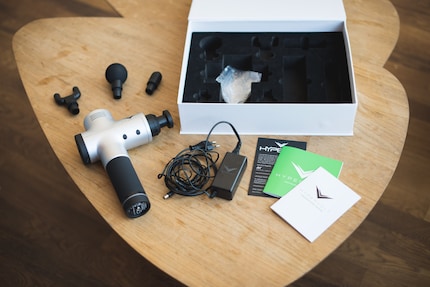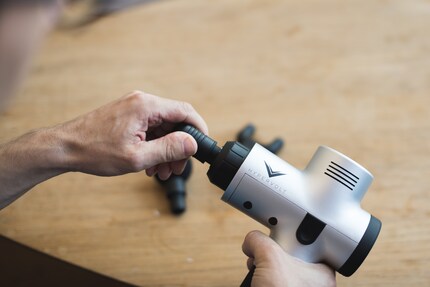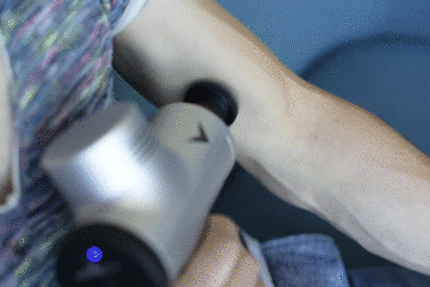

The impact drill for your muscles

When I hold the "Hypervolt" massager in my hand for the first time, I think of tools rather than wellness. That's how it should be, because Hyperice products are made for athletes. What can this impact drill do?
The success of Hyperice has been nothing short of fabulous. Founder Anthony Katz, a former history teacher and basketball coach, found fans among America's top athletes in record time with his first product. When he first became interested in the topic of regeneration, even the stars were still tying makeshift ice packs around their aching joints. With his neoprene compression ice sleeve, he struck a chord with the right people and sports stars, some of whom also became investors. When athletes like LeBron James, Kobe Bryant or Lindsey Vonn show up with your products, you've won. Since then, the company has gone from strength to strength. The "Hypervolt" is now the ultimate solution for pinpoint vibration massage. Both for activation before exercise and for regeneration afterwards. I'm curious to see what it feels like if you don't quite have the chest of a LeBron James and the thigh muscles of a Lindsey Vonn.
What's in the box?
- the body
- the battery/handle
- four massage attachments in plate, ball, bullet and fork shape
- a charger

Hyperice dispenses with bells and whistles and lengthy instructions. There's not much you can do wrong when assembling. The battery is pushed into the body until it clicks into place, although this requires a little effort. It only clicks into place at the last moment. You quickly discover that the charger can be plugged in at the bottom and the on/off switch next to it is also self-explanatory. However, the device only starts when you also press the button on the back of the body, which can be used to adjust the speed in three stages. The massage attachment of your choice is inserted beforehand and turned slightly, then you're ready to go. But which attachment? On which part of the body? And would you prefer 2000, 2600 or 3200 strokes per minute? This is explained by the cool Mr Katz himself in the video. I'll briefly summarise his explanations for you
.
Plate, fork, bullet, ball
- The ball is the softest attachment and can be used practically anywhere, good for beginners
- The disc is also very versatile, but harder and with a larger contact surface. Many users prefer to use it on the quadriceps (front thigh), gluteus (buttocks) and pectoralis (chest).
- The bullet attachment is designed to work on trigger points in a very targeted manner. You can use it to go deep into the tissue and also massage smaller areas of the body, for example on the feet.
- The fork is suitable for massaging the trapezius (neck), whereby the muscle is placed between the prongs and you can go into the tissue on both sides by rotating it. It also works well on the left and right of the Achilles tendon, which should be of interest to runners. And some also like to use the fork on the larger muscle areas. Says the boss.

The three speed levels: "It's up to you!"
- The starting speed of 2000 RPM is recommended by Mr Katz in the throat/neck area, where caution is advised
- 2600 RPM would be more suitable for the legs and calves
- At the highest level of 3200 RPM, hips, bum and quadriceps would be happy.
But the basic rule for everything is: "It's up to you!" Okay. When you buy a drill, you don't get a big explanation of where and how you can drill with it. The Hypervolt is also a tool. If you search for the hashtag on Instagram, you'll find lots of physiotherapists, athletes with muscle mountains that have been made to jiggle using the Hypervolt and this dog, who I'm not entirely sure is really enjoying the treatment.
Tried it out: It also works without LeBron stature
I start with the ball attachment on my thigh. The ball is slightly rubberised, the other attachments are made of lightweight hard plastic. Set the main switch to On, press the button on the back and off you go on level one. The Hypervolt is really surprisingly quiet, only a low hum can be heard. The "Booster" from Blackroll made more noise. Since almost the entire weight is in the handle due to the battery, the device can be held very well and stably. There is also an LED ring at the bottom of the handle that provides information about the battery charge status. It should last for around three hours. That would be over half a million shocks that shake your muscles.

This doesn't feel so violent - at least with the ball. Even as a mere mortal without LeBron stature. When you put it on, even at the lowest level, you don't feel individual impacts, but simply a constant vibration of the muscles. I work my thighs and upper arms before changing the attachment. Now it's the disc, whose large contact surface ensures even more effect with every hit. These two attachments remain my favourites, as I don't quite trust myself and the bullet when it comes to hitting trigger points and massaging deep into the tissue.
I also only use the fork briefly. I don't find it comfortable on the large muscles and I don't have a helping hand along the Achilles tendon and trapezius - it doesn't work well on its own. I used the Hypervolt repeatedly over a longer period of time and it's not easy to do it justice in my judgement. The build quality and performance are good, but the application is ultimately very individual. I didn't have a specific problem like Community member Pcevans, who used it to treat his tennis elbow and is very satisfied. And I'm reluctant to work on individual areas with greater pressure. What remains is a good self-massage that is so quiet despite the power that it is not annoying.
Conclusion
Does it need it? Is it really worth it? I had some reservations about the device at the beginning. The more I looked into it, the more I realised: It's not the Hypervolt that's the problem. It is a device that belongs in expert hands, as the physiotherapist I trust also believes. A tool for therapists and athletes who know what they are doing and want to work with it precisely. If this applies to you, then you are getting a high-quality product for your money that is also pleasantly quiet and lasts a long time. I would still prefer the "Booster" from Blackroll or the "Vyper" from Hyperice because the combination of fascia roller and vibration massage is more suited to my application profile. However, if I were to meet a physio with the Hypervolt, I would lie down on his couch without hesitation.



Simple writer and dad of two who likes to be on the move, wading through everyday family life. Juggling several balls, I'll occasionally drop one. It could be a ball, or a remark. Or both.


